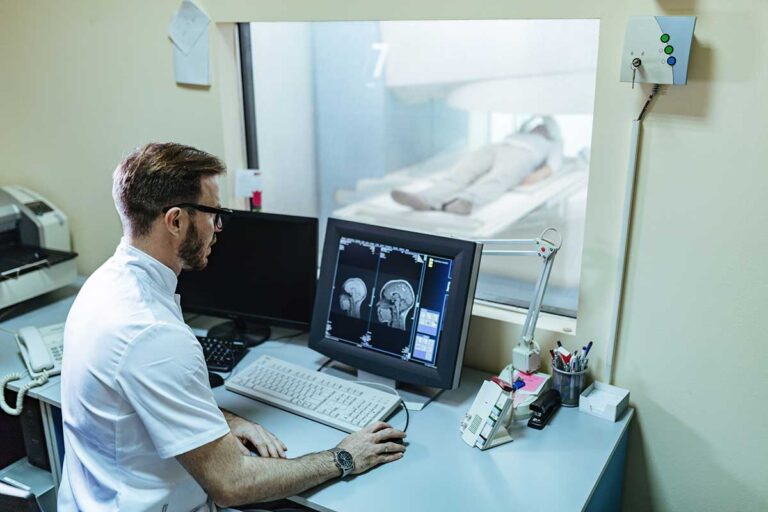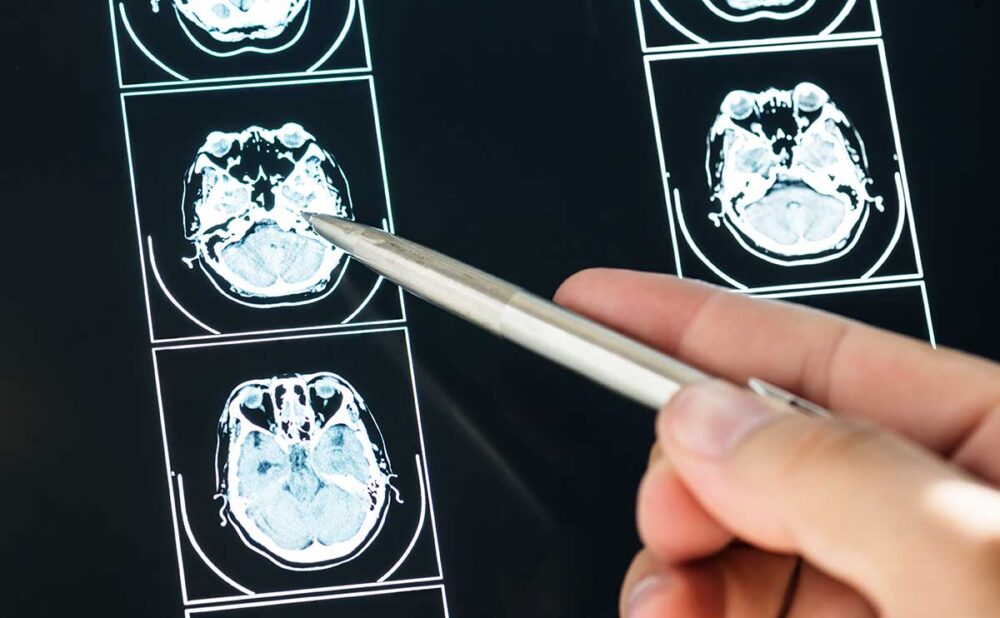The Hidden Dangers of Traumatic Brain Injuries in Car Crashes
Experiencing a traumatic brain injury due to an auto accident is a daunting reality that carries significant consequences. For those seeking clarity on symptoms, recovery processes, and legal recourse, this article addresses these critical issues directly. Join The Jewkes Firm as we explore the aftermath of traumatic brain injuries resulting from auto accidents, detailing everything from initial symptoms to the intricate path of recovery and the complexities of the legal system.
Key Takeaways
- Traumatic brain injuries (TBIs) resulting from auto accidents can vary in severity, with symptoms that may develop over time. Both immediate and long-term effects necessitate a range of treatment options, including medication, surgical intervention, and rehabilitation therapy.
- The diagnosis of TBIs involves a thorough evaluation of symptoms alongside advanced imaging techniques, such as CT scans and MRIs, and occasionally DTI or GRE for more subtle injuries, to inform treatment decisions and forecast patient recovery.
- Legal challenges that arise after a TBI encompass the management of claims, determination of liability, and pursuit of equitable compensation, influenced by factors such as the injury’s severity, individual circumstances, and applicable jurisdictional laws.
Suffering From A Traumatic Brain Injury? Contact Us For A Free Consultation
Suffering From A Brain Injury?
Causes and Types of Traumatic Brain Injuries from Automobile Accidents
For some individuals, surviving a vehicular collision marks merely the onset of a more arduous struggle. The true challenge arises in confronting the often-overlooked consequences: traumatic brain injuries. Direct impacts, such as the head colliding with the steering wheel, dashboard, or door, can result in contusions—bruises on the brain that may lead to debilitating headaches, dizziness, and nausea. These injuries are not only immediate but can also progress into more severe headaches, which may require surgical intervention. Although these traumatic incidents occur suddenly, the path to recovery is frequently extended, involving a complex interaction between primary brain injuries and subsequent complications.
In the tumult of automobile accidents, the brain is susceptible to a variety of injuries. Open head injuries may occur when objects, such as shards of glass, penetrate the skull, potentially affecting motor skills and communication abilities. Diffuse axonal injuries, which arise when the brain strikes the inner surface of the skull, result in torn nerve fibers—estimated to impact approximately 10% of patients admitted to hospitals for traumatic brain injuries. The ramifications of these injuries can range from mild concussions to severe brain damage, each presenting its own set of challenges and recovery paths. In certain instances, a secondary brain injury may arise, further complicating the overall condition.
Closed Head Injuries
A closed brain injury can occur even when the skull remains unbroken during a car accident, primarily due to the rapid movement and jarring of the brain within the skull. Such injuries are frequently seen in motor vehicle collisions and can present as concussions or more severe conditions, such as diffuse axonal injuries. These types of brain injuries are particularly insidious, as the damage takes place beneath the skull, invisible to external observation, yet capable of resulting in significant harm and lasting brain damage.
The symptoms associated with closed head injuries can vary widely, ranging from mild headaches to profound cognitive deficits. The intensity of the impact and the extent of brain movement within the cranial cavity determine the severity of injuries. Despite their concealed nature, closed head injuries represent over half of all traumatic brain injuries resulting from car accidents, establishing them as one of the most prevalent serious head injuries encountered by drivers.
Penetrating Injuries
The alarming truth about automobile accidents is that they can transform ordinary items into deadly projectiles. Penetrating injuries arise when external objects breach the skull and encroach upon the protective environment of the brain. Fragments of shattered glass or metal from a severe impact can penetrate the skull, resulting in open head injuries that necessitate urgent medical intervention and often require surgical procedures to extract foreign materials. The gravity of penetrating injuries sustained in a motor vehicle accident is significant—they pose a life-threatening risk and can lead to severe traumatic brain injury (TBI), making prompt and effective medical response essential.
Although the prospect of open head injuries is unsettling, comprehending the dangers associated with vehicular collisions can aid in preparation and response to such traumatic incidents. The consequences of a penetrating injury involve a complex relationship between the immediate surgical requirements and the long-term effects on cognitive function. The journey to recovery may be challenging, yet with appropriate medical care, there remains a possibility of regaining lost capabilities and adjusting to new circumstances.
Diffuse Axonal Injuries
In high-speed car crashes, the brain faces the risk of one of its most serious injuries: diffuse axonal injury (DAI). The brain’s long nerve fibers, known as axons, are stretched or torn when the head experiences rapid changes in speed. The Adams classification system categorizes the severity of DAI, ranging from mild to severe. In the most severe cases, there are often additional focal lesions in the brainstem. Such injuries frequently disrupt the brain’s communication and chemical processes, particularly impacting the corpus callosum and brainstem, and do so without necessarily involving skull fractures.
The subtlety of diffuse axonal injuries is evident in their microscopic alterations, which may not be easily detected through conventional imaging techniques such as CT or MRI scans. The ramifications of DAI are significant, often resulting in serious cognitive and motor impairments, and in certain instances, irreversible brain damage. The recovery trajectory for individuals with DAI is intricate and unpredictable, with each case presenting distinct challenges and varying potential outcomes.

GEORGIA PERSONAL INJURY LAWYER NEAR ME

Traumatic Brain Injuries: From Symptoms to Diagnosis
The manifestations of a traumatic brain injury (TBI) following a car accident can differ widely among individuals. Symptoms may range from subtle cognitive difficulties to pronounced physical impairments, influenced by the nature and location of the injury. The Glasgow Coma Scale (GCS) is an essential instrument for evaluating consciousness levels, with scores categorizing the severity of the TBI into mild, moderate, or severe. While some symptoms may be immediately noticeable, others may develop or become apparent over time, underscoring the importance of accurate diagnosis and timely medical intervention.
Both children and adults can present distinct symptoms after a TBI. Children may display unique signs such as alterations in feeding or sleeping patterns and heightened irritability. In contrast, adults might experience ongoing headaches, memory issues, and emotional fluctuations, among other symptoms. Identifying these indicators is crucial for obtaining prompt diagnosis and treatment, which can greatly influence the recovery trajectory and overall prognosis.
Symptoms
The manifestations of a mild traumatic brain injury can present in various forms, with a spectrum of symptoms that may range from mild to severe. Commonly observed symptoms include:
- Physical manifestations such as headaches and dizziness
- Cognitive difficulties, including challenges with concentration
- Emotional fluctuations, such as irritability and changes in personality
- Sensory alterations, which may involve blurred vision or tinnitus
These symptoms can lead to a disorienting experience for the affected individual.
In children, symptoms may differ from those seen in adults, as pediatric traumatic brain injuries can impact sleep patterns, eating behaviors, and even interest in toys and activities. The diversity of symptoms highlights the necessity for personalized attention and care following a TBI, as each individual’s experience and recovery process is distinct.
Diagnostic Assessments
The diagnosis of a traumatic brain injury is an essential phase in the recovery process. Healthcare providers employ various diagnostic imaging techniques, including CT scans and MRIs, to assess the degree of brain injury. In cases of more subtle injuries, such as diffuse axonal injury (DAI), advanced methods like diffusion tensor imaging (DTI) and gradient-recalled echo (GRE) MRI can significantly improve detection, particularly in severe instances. These sophisticated imaging modalities play a vital role in the initial treatment stages, as they inform medical interventions and assist in outcome predictions.
In addition to imaging, neuropsychological evaluations offer a thorough analysis of the impact of a brain injury on an individual’s cognitive abilities, facilitating the creation of a customized rehabilitation strategy. Timely diagnosis is crucial for addressing the multifaceted challenges associated with a TBI, and with appropriate diagnostic tools, healthcare professionals can establish a solid foundation for effective treatment and optimistic recovery.
Injured In A Car Wreck? Contact Us For A Free Consultation
Injured In A Car Wreck?
Treatment and Rehab for Traumatic Brain Injuries
Addressing the consequences of a traumatic brain injury necessitates a comprehensive strategy, involving a collaborative effort among healthcare professionals to oversee the neurological, surgical, and rehabilitative dimensions of care. The primary objective is to lessen the injury’s effects, promote recovery, and enhance the patient’s overall quality of life. The intricate nature of TBIs requires tailored treatment plans that cater to the specific needs and situations of each individual.
Rehabilitation therapy serves as a vital source of hope for individuals facing the challenges posed by a brain injury. You can regain independence and restore functions that may have been impaired by this means. Through focused interventions and therapeutic approaches, patients can achieve notable progress in their recovery, utilizing the brain’s extraordinary capacity for adaptation and healing. The involvement of family and friends is crucial in this process, providing essential emotional support and motivation throughout the journey.
Medication
Effective management of medication is an essential aspect of the treatment strategy for traumatic brain injuries, with prescriptions specifically designed to meet the unique requirements stemming from various affected brain regions. The range of medications available addresses the multifaceted challenges encountered by TBI patients, which include:
- Antiepileptic agents to avert seizures
- Antidepressants aimed at mood regulation
- Sleep medications to address sleep issues
- Stimulants to enhance attention capabilities
- Anti-anxiety drugs to alleviate anxiety symptoms
- Antipsychotic medications to control aggression and agitation
Symptom management necessitates meticulous consideration and continuous monitoring to achieve optimal results. It is crucial for patients to collaborate closely with their healthcare professionals to identify the most effective medication plan.
In certain instances, doctors may prescribe preventive medications to mitigate potential complications, acting as a protective measure against further health issues for the patient. The judicious application of medication can ease symptoms, prevent secondary complications, and facilitate the overall recovery journey, underscoring the significance of a well-coordinated medication strategy in the treatment of TBI patients.
Surgery
Surgical intervention serves as a crucial option for individuals suffering from traumatic brain injuries, especially in cases where it is necessary to alleviate intracranial pressure or to mend structural impairments. Various procedures include:
- Decompressive craniectomy, which provides essential space for an inflating brain
- Craniotomy, aimed at addressing blood clots or injured blood vessels to avert additional harm
- Surgical elevation, which may be necessary to rectify deformities and safeguard the underlying brain tissue in patients with depressed skull fractures.
Although these surgical procedures are intricate, they can be life-saving and significantly contribute to a more favorable recovery trajectory. The application of advanced surgical techniques and technologies allows neurosurgeons to reduce damage and improve patient outcomes, highlighting the vital importance of surgery in managing severe traumatic brain injuries.
Rehabilitation Therapy
Rehabilitation therapy serves as a fundamental aspect of recovery for individuals who have sustained traumatic brain injuries, aiming to restore maximum function and independence. Various forms of rehabilitation therapies include:
- Physical therapy, which enhances mobility and balance
- Cognitive rehabilitation therapy, which strengthens cognitive functions such as memory and executive skills
- Neuromuscular re-education, which assists patients in regaining muscle control
- Gait training, which concentrates on improving walking abilities and coordination
- Vestibular training, which aids patients in achieving better balance and spatial awareness
These therapeutic approaches can profoundly influence a patient’s capacity to manage daily activities following an injury.
The effectiveness of rehabilitation therapy is significantly affected by environmental elements, particularly the availability of a supportive social network. Family and friends play a vital role in providing essential support, aiding in home exercise routines, and engaging in therapy-related decisions. The brain’s remarkable adaptability, through its inherent plasticity, offers hope in the rehabilitation journey, as it enables individuals to recover lost abilities and discover new methods for performing tasks.

Recovery Process and Prognosis for Traumatic Brain Injuries
A person with a significant traumatic brain injury goes through phases of altered consciousness and gradual enhancement during the recovery process. The extent of the injury plays a crucial role in determining the intricacy of the recovery process, with various elements affecting both the duration and quality of healing. Notable factors that can influence recovery include:
- Age. Younger individuals generally exhibit more favorable outcomes than their older counterparts.
- Access to rehabilitation services. Those who have access to high-quality rehabilitation services often experience improved recovery results.
- Socioeconomic status. A higher socioeconomic status can also have a beneficial effect on recovery.
These elements underscore the significance of age and socioeconomic factors in the recovery journey.
Prompt and effective medical intervention is another critical factor that influences a positive recovery path, emphasizing the necessity of immediate medical care and appropriate rehabilitation following a TBI. Although the long-term recovery and prognosis for individuals with TBI may initially appear uncertain, as the patient responds to treatment and advances through rehabilitation, a more definitive understanding of their future capabilities and requirements will develop.

Legal Considerations and Compensation
Individuals affected by a traumatic brain injury resulting from a car accident often find the legal process to be as challenging as the injury itself. Legal considerations and compensation are vital components of this situation, involving the filing of claims, establishing liability, and pursuing just compensation for the damages sustained.
Consulting with a knowledgeable brain injury attorney at The Jewkes Firm, LLC, can offer essential support in navigating this intricate process, ensuring that victims obtain the necessary resources for their recovery and future health.
The quest for compensation generally encompasses economic damages, such as medical costs and lost income, alongside non-economic damages that reflect pain and suffering, emotional distress, and other personal hardships. Determining a fair settlement or court-awarded compensation is a complex endeavor, with amounts varying considerably based on individual circumstances and the extent of the injury.
Additionally, the litigation process itself may affect the recovery journey, potentially extending symptoms and complicating the healing process.
Filing Claims
Filing a claim for a traumatic brain injury necessitates a clear demonstration of liability and a comprehensive gathering of evidence to substantiate the claim. Key documentation includes medical records, police reports, witness statements, and photographs of the accident site. Testimonies from both eyewitnesses and experts are vital in reinforcing the claim, with medical professionals offering insights into the nature and consequences of the injury.
The importance of ‘before and after’ witnesses is significant, as they illustrate the severe impact of a TBI on the victim’s cognitive functions, personality, and overall quality of life. To ensure that all pertinent information is accurately presented and evaluated, one must pay meticulous attention during the claim-filing process.
Establishing Liability
Determining liability is a critical component in legal cases involving traumatic brain injuries. To establish negligence, it is necessary to demonstrate that the opposing party:
- Did not exercise the level of care that a reasonably prudent individual would have under comparable circumstances
- Committed a breach of duty
- Directly contributed to the injury and the subsequent damages
It is vital to connect the specific breach of duty to the traumatic brain injury incurred in order to construct a persuasive case.
An injured individual in Georgia can seek damages even if they contributed to the incident, but any compensation they receive will be reduced by the degree of their fault, according to the doctrine of modified comparative negligence. Engaging with an attorney from The Jewkes Law Firm, who is well-versed in these complexities, is essential for those pursuing justice and compensation, as the intricacies of the legal system can be as complicated as the medical issues related to the injuries sustained by you or a loved one.
Compensation
Compensation for traumatic brain injuries resulting from automobile accidents encompasses more than just the immediate medical expenses. It also includes future medical needs, lost income, and diminished earning potential, reflecting the extensive financial repercussions of the injury. Additionally, non-economic damages are significant, addressing pain and suffering, emotional turmoil, and the loss of enjoyment in life—highlighting the deep personal effects of such injuries.
The settlement amounts for brain injuries can vary widely, influenced by factors such as the injury’s severity and the specific circumstances of the individual. While typical settlements fall between $700,000 and $1.2 million, the precise compensation is customized for each situation. Working with an experienced personal injury attorney at The Jewkes Law Firm can significantly improve your understanding of the process and increase the chances of obtaining a favorable outcome. We can navigate the complexities of the law and advocate for comprehensive and equitable compensation.
Need a Free Consultation? Need a Skilled Attorney?
Free Consultation
Call (770) 771-5130
If you’ve been injured, you need to hire the best legal care to assist you with your claim. Get a FREE consultation today!
Strategies for Preventing Traumatic Brain Injuries in Auto Accidents
The most effective approach to managing a traumatic brain injury is to prevent its occurrence altogether. Implementing safety protocols such as consistently wearing a seat belt, refraining from driving while impaired, and ensuring that airbag and seat belt systems are functioning properly can greatly diminish the likelihood of head injuries during a vehicular collision.
Moreover, taking additional steps such as installing penetration-resistant side window glazing and incorporating padding materials in the vehicle’s upper interior can further decrease the risk of traumatic brain injuries.
For those who cycle or ride motorcycles, the use of protective headgear is essential in safeguarding against head injuries in the event of an accident. Energy-absorbing headbands and soft shell helmets provide an extra layer of protection that can significantly influence the outcome of a crash.
By embracing these preventive strategies, individuals can markedly lower their risk of experiencing a traumatic brain injury in the event of an automobile accident.
Summary
Throughout the intricate process from the initial impact to the subsequent recovery, it is essential to comprehend traumatic brain injuries resulting from automobile accidents. We have examined the different categories of injuries, their associated symptoms, and the comprehensive strategies for treatment and rehabilitation. Additionally, we have addressed the legal complexities involved and emphasized the significance of pursuing suitable compensation. Ultimately, we have highlighted the critical role of prevention in protecting against these transformative injuries. With this understanding, we aspire for you and your family to confront the challenges posed by TBI with strength and optimism, recognizing that recovery is an ongoing journey rather than a final goal.





